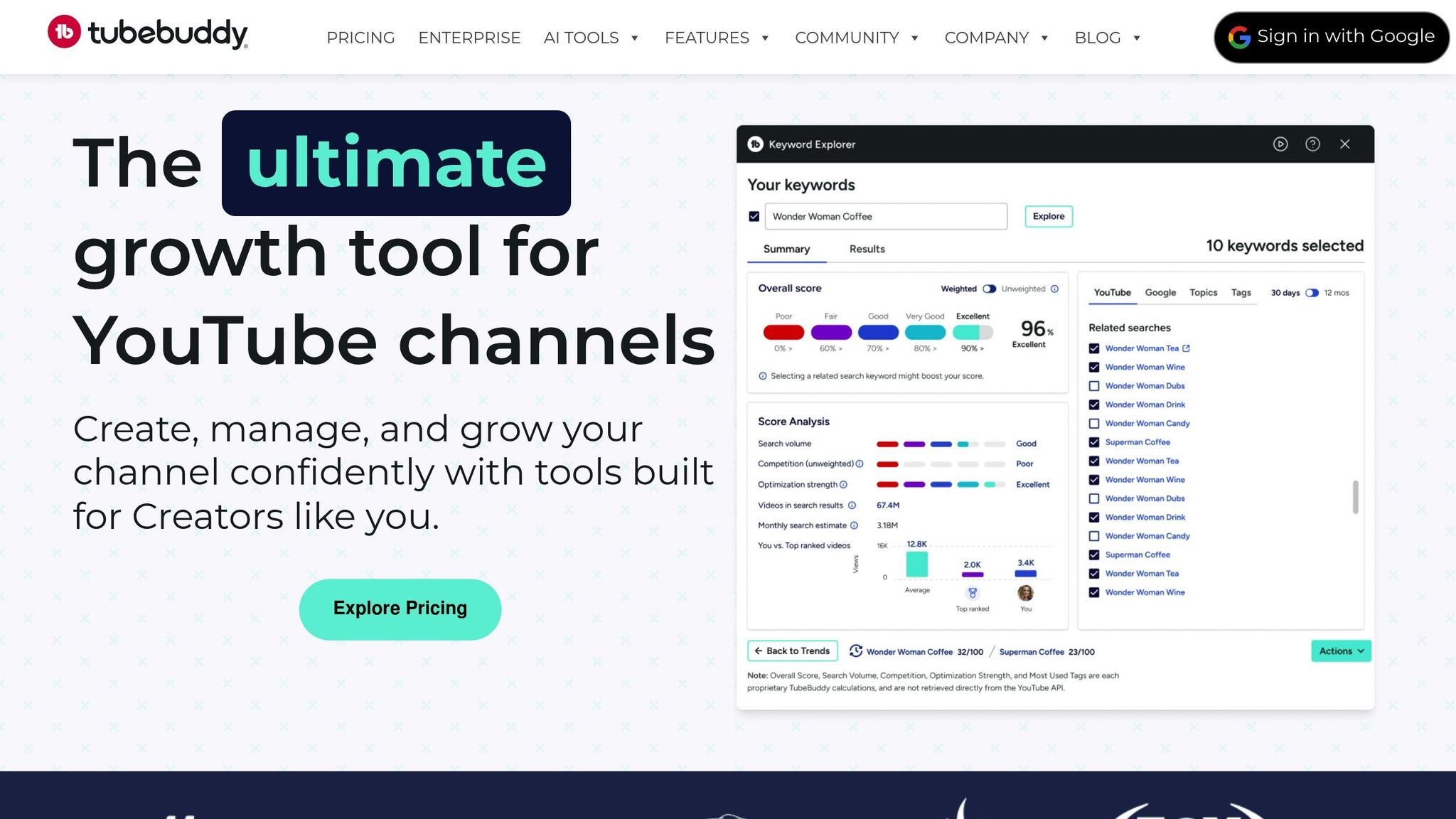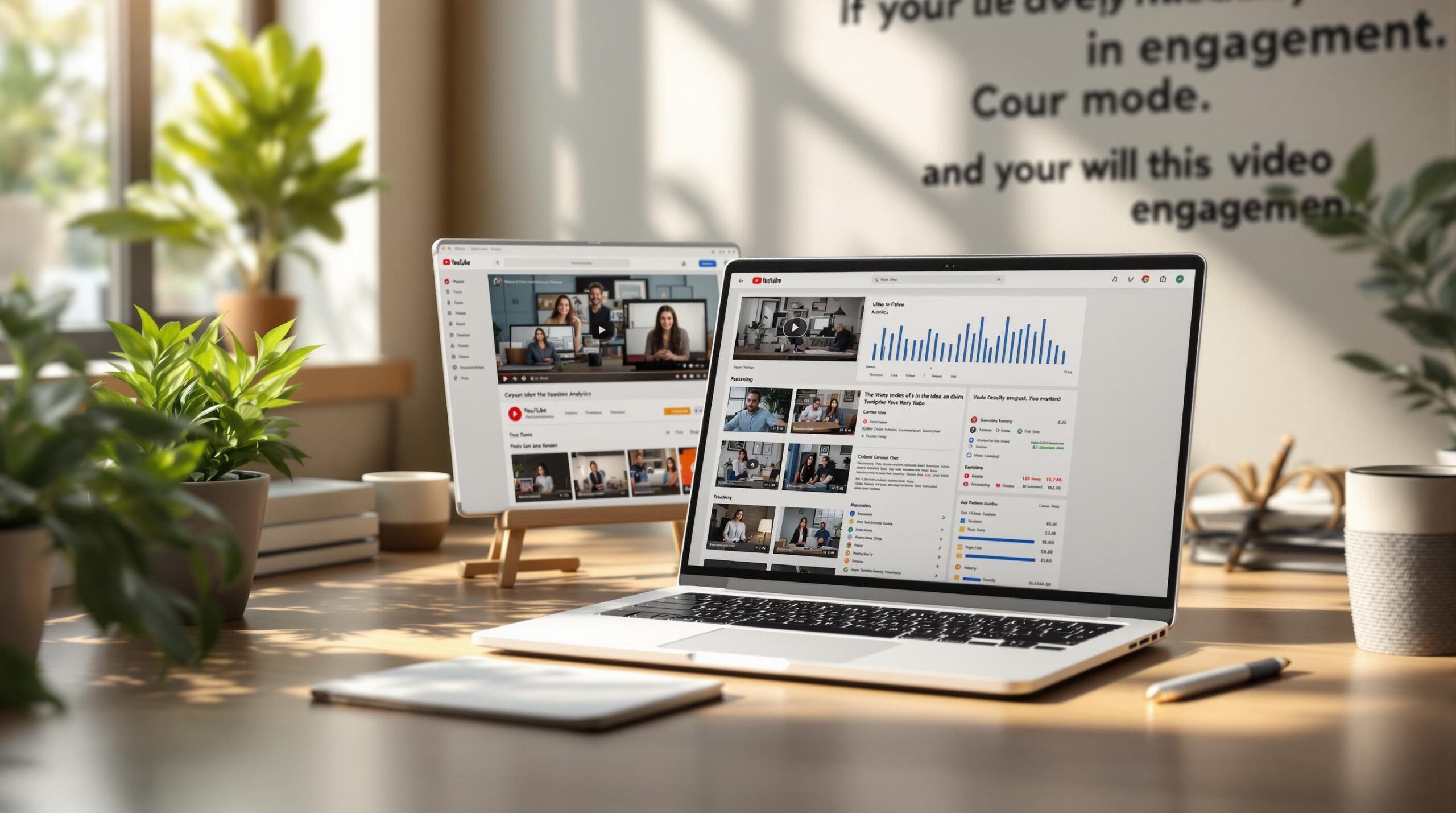Want your YouTube videos to rank higher and get more views? Here’s how: YouTube SEO is about optimizing your videos so they’re more visible in search results and recommendations. With over 500 hours of video uploaded every minute and 70% of views coming from recommendations, standing out requires strategy.
Key Takeaways:
- Use Keywords Effectively: Add them to titles, descriptions, tags, and even your video file name.
- Create Click-Worthy Titles & Thumbnails: Use numbers, power words, and eye-catching designs.
- Boost Engagement: Encourage likes, comments, and subscriptions with clear CTAs.
- Focus on Analytics: Track metrics like watch time and retention to improve content.
- Add Captions & Transcripts: They improve accessibility and boost SEO.
Quick Comparison: SEO Tools for Keywords
| Feature | TubeBuddy | vidIQ |
|---|---|---|
| Keyword Explorer | Weighted keyword scores | Keyword inspection |
| Competition Data | Shows keyword competition | Highlights related trends |
| Search Volume | Monthly search volume | Search trend insights |
Pro Tip: Design your thumbnail and title before recording to ensure your video delivers on its promise.
Ready to grow your channel? Let’s dive into the details.
Related video from YouTube
Finding and Using Keywords
Keyword research is key to making your videos more visible. It helps match your content with what people are searching for and boosts engagement through search results and suggested videos.
YouTube Search Bar Tips
Use YouTube’s search bar to uncover what viewers are searching for. Start typing your topic, and pay attention to the auto-suggestions – it’s a goldmine of popular queries.
For instance, if your video is about coffee brewing, typing "how to brew" might show these suggestions:
- how to brew coffee in a French press
- how to brew espresso at home
- how to brew pour-over coffee
These suggestions highlight what your audience is actively searching for. To dig even deeper, tools like TubeBuddy and vidIQ can give you more detailed keyword insights.
TubeBuddy and vidIQ Tools

Both TubeBuddy and vidIQ are great for refining your keyword strategy. Here’s a quick comparison:
| Feature | TubeBuddy | vidIQ |
|---|---|---|
| Keyword Explorer | Offers weighted keyword scores | Provides keyword inspection |
| Competition Analysis | Shows keyword competition data | Highlights related trends |
| Search Volume | Displays monthly search volume | Provides search trend insights |
Keyword Placement Guide
Where you place keywords in your video content matters. It helps YouTube understand your video and makes it easier for viewers to find.
- Video Title: Include your main keyword within the first 60 characters. This grabs attention and signals relevance.
- Video Description: Use your primary keyword in the opening sentences and sprinkle related terms naturally throughout. Avoid overloading with keywords – it looks spammy.
"When you’re working with YouTube SEO, think about where you’re placing your keywords. It’s like leaving breadcrumbs for viewers to find your videos. Put these keywords in your video’s file name, title, description, and tags." – Kate Ross, SEO of Irresistible Me Hair Extensions
- Tags: Start with your main keyword, then add related ones. Use 5-8 relevant hashtags to improve discoverability and provide context.
To stay organized, create a keyword map. This can help you track search volume, competition, and rankings across your videos.
Titles and Descriptions That Work
Crafting the right titles and descriptions goes beyond just adding keywords. It’s about finding the perfect balance between optimizing for search engines and grabbing viewers’ attention. A solid approach to both can improve your video’s visibility and engagement.
Writing Strong Titles
Your video title plays a major role in search rankings and how often users click on your video. Studies suggest top-ranking videos often have titles around 47–48 characters long.
Here’s how to create stronger titles:
- Front-load Keywords: Start your title with your main keyword to grab attention quickly.
- Use Attention-Grabbing Elements: These can make your title stand out. Here’s a quick breakdown:
| Title Element | Purpose | Example Format |
|---|---|---|
| Numbers | Add specificity | "7 Ways to…" |
| Brackets | Highlight content type | "[Tutorial]" |
| Power Words | Trigger emotions | "Ultimate", "Essential" |
| Time Frame | Create urgency | "2025 Guide" |
- Mobile-Friendly Titles: With 70% of YouTube watch time happening on mobile devices, keep your titles between 60–70 characters to ensure they display fully on smaller screens.
Once your title is set, focus on writing a description that complements it.
Description Writing Guide
Your video description provides essential context for viewers and YouTube’s algorithm. A well-thought-out description can boost your video’s performance.
- Focus on the First 25 Words: Make sure your primary keyword appears within the first 25 words.
- Write Longer Descriptions: Aim for at least 250 words, naturally including your main keyword 2–4 times.
- Include These Key Elements:
- Start with your primary keyword in the opening sentence.
- Add 3–5 relevant hashtags to improve discoverability.
- Use timestamps for videos longer than 5 minutes to help viewers navigate.
- Add clear calls to action (CTAs) to guide viewers on what to do next.
Research shows that videos with detailed descriptions and captions experience a 12% increase in watch time. By focusing on descriptions that offer value to both viewers and YouTube’s algorithm, your content is more likely to perform well.
Video and Metadata Setup
Video Quality Standards
Shoot your videos in HD (1080p) or higher to ensure they look sharp on any device. Here’s what you need:
| Equipment Type | Minimum Standard | Best Option |
|---|---|---|
| Camera | 1080p HD Camera | 4K-capable Camera |
| Lighting | Single Ring Light | 3-point Lighting Setup |
| Audio | Built-in Mic | External Lavalier or Shotgun Mic |
| Stabilization | Handheld | Tripod or Gimbal |
Good audio is just as important as visuals. Poor sound can drive viewers away, so use high-quality mics and record in quiet spaces with minimal echo. Once your video looks and sounds great, it’s time to focus on metadata to strengthen your video’s visibility.
Metadata Setup Steps
Metadata helps YouTube understand and recommend your video to the right audience. Follow these steps to set it up properly:
- File Naming: Rename your video file to include your main keyword before uploading, like
youtube-seo-guide-2025.mp4. - Category Selection: Pick the most specific category that matches your content. Avoid general categories like "Education" or "Entertainment" when more focused options are available.
- Tags: Use a mix of tags to increase discoverability. Here’s how to structure them:
| Tag Type | Purpose | Example |
|---|---|---|
| Primary | Your main keyword | "YouTube SEO" |
| Secondary | Related terms | "video optimization" |
| Branded | Your channel or brand name | "Creator Academy" |
| Competitor | Popular similar channels | Channel names in your niche |
- Closed Captions: YouTube’s auto-captions are only about 70% accurate. Uploading custom SRT files not only improves accuracy but can also increase viewership by 12%.
Thumbnail Creation
Once your metadata is set up, the next step to improving video performance is creating eye-catching thumbnails. Custom thumbnails are a game-changer for YouTube SEO. In fact, 90% of top-performing videos feature custom thumbnails. A thoughtfully designed thumbnail can drive more clicks and boost rankings, as YouTube rewards content that keeps viewers engaged.
Making Effective Thumbnails
A good thumbnail focuses on a few key elements:
| Element | Best Practice | Impact on SEO |
|---|---|---|
| Image Resolution | 1,280 x 720 pixels (16:9) | Crisp visuals on all devices |
| Text Length | 4-5 words maximum | Easy for viewers to scan |
| Background | High contrast, simple design | Stands out in search results |
| Mobile Optimization | Tailored for mobile users (54.4% of traffic) | Better performance |
For example, the science channel Veritasium used A/B testing to refine their thumbnail strategy, leading to a 50% increase in views.
"Your thumbnail isn’t just a pretty picture; it’s a critical decision-maker for viewers torn between your video and another’s." – Emily Malone, Marketing Manager, Venture Videos
Branding Your Thumbnails
Consistent branding in thumbnails helps viewers instantly recognize your content. Here’s how some successful channels do it:
- Color Consistency: Cocomelon uses bright primary colors across all their thumbnails, making their videos easy to spot. This approach has played a role in growing their audience to 165 million subscribers.
- Visual Templates: The Angry Birds YouTube channel uses consistent templates with matching color schemes and logo placement for their Slingshot Stories series. This strategy has helped them build a subscriber base of over 6 million.
To create professional thumbnails, consider using these tools:
| Tool | Key Features | Best For |
|---|---|---|
| Fotor | AI editing, background removal | Advanced customization |
| Canva | Pre-made templates, brand kit storage | Quick and easy designs |
| Visme | Professional templates, customization | Maintaining brand consistency |
Captions and Transcripts
Adding captions and transcripts can improve SEO, make content more accessible, and increase viewership. Discovery Digital Networks found that captioned videos gained 7.32% more views on average. Similarly, PLYMedia reported that viewers were 80% more likely to watch videos all the way through when captions were included.
Caption Setup Guide
| Caption Type | Benefits | Best Use Case |
|---|---|---|
| Manual Captions | Most accurate, SEO-friendly | Professional content, technical terms |
| Auto-sync Captions | Quick to create, budget-friendly | Clear audio, standard language |
| Multilingual Subtitles | Broader audience reach | Targeting international viewers |
Accurate captions are essential, and using the right tools is key. Auto-generated captions can be a good starting point, but a manual review ensures they’re correct, especially for technical or industry-specific terms.
"Not many YouTube users however realize that closed captions and transcripts positively influences user engagement, watch time, viewership, and obviously SEO." – CaptioningStar
In addition to captions, transcripts make videos more searchable and engage viewers further.
Transcript Benefits
To get the most out of transcripts, follow these strategies:
- Keyword Integration: Naturally include target keywords in your transcript.
- Description Optimization: Add a summarized version of the transcript in the video description.
- Content Repurposing: Use transcripts to create blog posts or social media content.
Transcripts, much like keywords in titles or descriptions, help YouTube’s search algorithms by naturally integrating keywords. For example, This American Life transcribed its audio archive and saw 6.26% of search traffic land directly on transcript pages. A Liveclicker study also showed that adding transcripts to 37 web pages increased revenue by an average of 16%.
"Transcripts and captions allow Google to crawl everything that is said in your video, increasing not only your keyword density but also your keyword diversity." – Elisa Lewis, 3PlayMedia
To make transcripts effective, ensure they are:
- Timed accurately with the video
- Clear and easy to read
- Enriched with relevant keywords
- Available in multiple languages when necessary
With 80% of YouTube views coming from outside the U.S., multilingual transcripts are especially useful for reaching a global audience. Brad Ellis, YouTube Product Manager at Google, highlights this: "80% of views on YouTube come from outside of the United States, which is huge, and much of it is non-English…it was a huge opportunity for growth".
Captions and transcripts are essential tools in your YouTube SEO strategy, working alongside other optimization efforts to boost your video’s reach and performance.
Viewer Interaction Methods
Engaging viewers plays a key role in how YouTube ranks your videos. Metrics like likes, comments, and subscriptions can directly influence your video’s position in search results. In fact, studies show that videos with more interaction tend to perform better in rankings.
Getting More Engagement
Using well-placed calls-to-action (CTAs) can dramatically boost engagement. For instance, Brian Dean added video annotations encouraging viewers to like his content, leading to a 300% increase in likes in just one week. Similarly, food creator Rosanna Pansino achieves an impressive 10–30% click-through rate on her end-card annotations.
| Engagement Type | Timing Suggestion | Proven Results |
|---|---|---|
| Subscribe CTA | At the end of the video | 3,100% subscription increase |
| Like Request | Strategically placed | 300% increase in likes within one week |
| End Cards | At the end of the video | 10–30% click-through rate |
To get the most out of your CTAs, follow these tips:
- Strategic Timing: Place your main CTA when viewers are most engaged.
- Clear Instructions: Spell out exactly what you want viewers to do.
- Value Proposition: Explain why their action matters.
- Visual Cues: Use annotations and end screens to guide their attention.
Another key factor in boosting engagement is managing your comments effectively. Responding to comments builds a sense of community and can further improve your video’s visibility.
Comment Management
Strong comment management takes your engagement to the next level. Here are some effective strategies:
| Management Strategy | Purpose | Implementation |
|---|---|---|
| Quick Response Time | Encourages more interaction | Reply to comments within 24 hours |
| Comment Pinning | Highlights valuable discussions | Pin insightful or helpful comments |
| Spam Control | Maintains quality | Use YouTube’s moderation tools |
| Community Building | Builds loyalty | Personalize responses by using viewer names |
When replying to comments, aim for quick, thoughtful responses. Acknowledge constructive feedback, stay professional when addressing criticism, and avoid overusing emojis. Keep your replies concise to maintain clarity.
Interactive features like these can transform passive viewers into active participants. For example, Shopify uses YouTube Shorts to share quick tips and then directs viewers to longer videos for more details. This approach has been shown to increase engagement by up to 44%.
YouTube Analytics Guide
YouTube Analytics helps boost SEO by shedding light on viewer behavior and channel performance. Here’s a breakdown of the key metrics you should keep an eye on.
Key Performance Metrics
YouTube places a strong emphasis on watch time when ranking content. As Neil Patel explains, "Watch time is the total amount of minutes viewers have spent watching your videos…YouTube’s algorithm presumes that a higher watch time indicates an engaging video, so it elevates videos and channels with higher watch times in the search results and recommendations section".
| Metric Category | Key Metrics to Track | Why It Matters |
|---|---|---|
| Engagement | Watch time, retention rate, likes, comments | Indicates content quality and audience interaction |
| Reach | Impressions, click-through rate, unique viewers | Measures how well your content is being discovered |
| Audience | Demographics, subscriber growth, traffic sources | Helps tailor content to your viewers |
| Technical | Card clicks, end screen performance | Evaluates navigation and usability |
Subscribers are particularly important, as they watch twice as much content as non-subscribers. This makes growing your subscriber base a key factor in improving your channel’s performance.
Using Analytics to Improve
Leverage these strategies to turn analytics into actionable improvements:
| Analytics Focus | Implementation Strategy | Expected Outcome |
|---|---|---|
| Watch Time Analysis | Group videos by theme and length | Discover which formats keep viewers engaged |
| Retention Patterns | Identify audience drop-off points | Adjust video structure to maintain interest |
| Traffic Sources | Analyze how viewers find your content | Refine your promotional efforts |
| Keyword Performance | Update metadata based on trends | Boost your content’s visibility in search |
Phil Nottingham, a Marketing Strategist, highlights: "YouTube is as much a social network as it is a search engine. So optimizing content for discovery on YouTube is not only about getting the highest Google and YouTube rankings. It’s also about ensuring you appear frequently in the recommended video results, and generate as much engagement (in terms of shares, likes and comments) as possible on your videos".
With over 70% of YouTube watch time coming from mobile devices, it’s essential to ensure that your titles, thumbnails, and descriptions are mobile-friendly. They should be clear and visually appealing, even on smaller screens.
Here are some practical steps you can take based on your analytics:
- Monitor Impressions CTR: If your click-through rate is high, it means your titles and thumbnails are effectively grabbing attention.
- Track Audience Retention: Pinpoint sections of your videos that keep viewers watching and address areas where they drop off.
- Analyze Traffic Sources: Focus your promotional efforts on platforms or sources that bring in the most engaged viewers.
- Review Revenue Data: Identify which videos generate the highest ad earnings and consider creating similar content.
Conclusion
YouTube SEO is all about finding the right mix between technical accuracy and creating an enjoyable viewer experience. Research shows that videos with proper optimization tend to perform better than those without.
Several factors influence both visibility and engagement. Here’s a quick breakdown:
| Focus Area | Impact | Key Metrics |
|---|---|---|
| Technical SEO | Easier discovery | Search rankings, impressions |
| User Experience | Better engagement | Watch time, retention rate |
| Content Quality | Sustainable growth | Subscriber growth, shares |
Using keywords strategically helps YouTube understand your video’s purpose. Well-optimized visuals and metadata also play a big role in boosting your video’s reach.
The platform is always evolving, bringing new opportunities. For instance, YouTube Shorts now racks up an astonishing 70 billion daily views. As trends shift, your strategies should too. To maintain strong rankings, focus on the following:
- Keep an eye on analytics, update older videos with fresh metadata, stick to a consistent posting schedule, and experiment with different thumbnail designs to see what resonates .
- Plan every detail – like your thumbnail and title – so they match the content you’re delivering.
"The secret is to craft your thumbnail before making the video, not at the time of upload, so the video itself delivers on the thumbnail. The best YouTubers sort out their thumbnail and title before hitting record."




